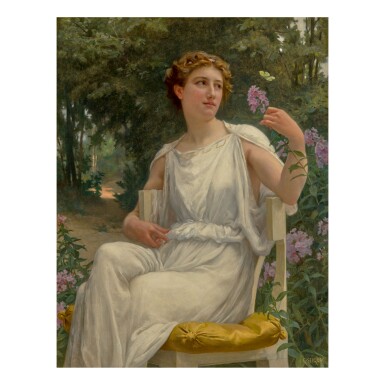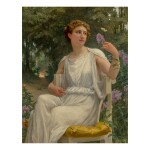19th Century European Art
19th Century European Art

Property from a Private Southern Collection
GUILLAUME SEIGNAC | A BEAUTY OF NATURE
Auction Closed
January 31, 04:23 PM GMT
Estimate
60,000 - 80,000 USD
Lot Details
Description
Property from a Private Southern Collection
GUILLAUME SEIGNAC
French
1870 - 1924
A BEAUTY OF NATURE
signed G-SEIGNAC (lower right)
oil on canvas
41¼ by 32⅛ in.
104.8 by 81.6 cm
Messrs. H. & P. de Casseres, London
Private Collection, Indiana
Acquired from the estate of the above
Guillaume Seignac’s graceful model reflects the Academic ideals that earned his fame in the nineteenth century, and those of his teacher at the Académie Julien, William Bouguereau. Embracing the classical subject matter and technical mastery of the Renaissance, the nineteenth century production of allegorical scenes of beautiful women in classical dress found critical success at the Paris Salons, and Seignac’s work earned a place in the great private collections of Europe and America.
With the present work, Seignac demonstrates his highly trained skills through the naturalistic representation of his model: her tender grasp on the sprig of lilacs and her thoughtful gaze falling on the small yellow butterfly invite the viewer to interrupt her solitude, while the tonal depths of her skin deepen from alabaster to a soft blush. Her robes, despite their modesty, reveal the carefully modeled form of the body underneath.
Seignac’s women combine portraits of modern Parisian women with ancient dress and pastoral scenery to create an escape from an increasingly industrialized world in an imagined classic idyll. The peaceful refuge of the glade masks the careful academic technique of the work. The brushwork seamlessly transitions from light-dappled path to the soft petals of the lilacs, and the fabric flowing over smooth skin, are testaments to Seignac’s masterful skill.
Seignac often included a variety of blooms in his compositions, likely to suggest symbolic meanings. In the “flower language” popular in many nineteenth century social circles, lilacs were gifted between lovers to privately express their devotion. Traditionally blooming around Easter, they are symbolic of both rebirth and fortitude.
